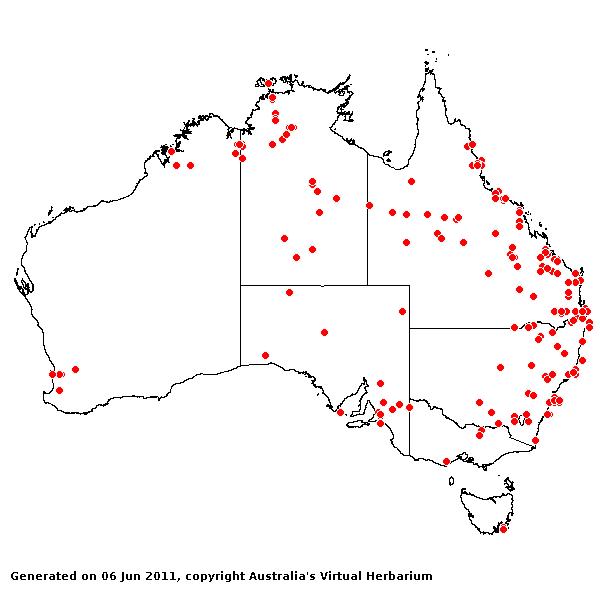Sorghum bicolor* (L.) Moench. Meth.
Pl. 207 (1794).
Classification. (GPWG 2001) : Subfamily
Panicoideae. Andropogoneae.
Basionym and/or
Replacement Name: Holcus bicolor
L., Mant. Pl. 2: 301 (1771).
Type of Basionym or
Protologue Information: LT: Herbium Cliffordianum 468. Holcus 1,
(BM). LT designated by Davidse in Cafferty et al., Taxon 49(2): 251
(2000).
Key references
(books and floras): [1952] C.A.Gardner, Flora of Western Australia 1
Gramineae (317 as S. vulgare), [2002] D.Sharp & B.K.Simon, AusGrass,
Grasses of Australia, [2006] J.Jessop, G.R.M.Dashorst, F.M.James, Grasses
of South Australia (531), [2008] S.W.L.Jacobs, R.D.B.Walley &
D.J.B.Wheeler, Grasses of New South Wales (372).
Illustrations:
[2006] J.Jessop, G.R.M.Dashorst, F.M.James, Grasses of South Australia (531, Fig. 453), [2008] S.W.L.Jacobs,
R.D.B.Whalley & D.J.B.Wheeler, Grasses of New South Wales, 4th edn
(372).
Habit. Annual.
Rhizomes absent. Culms erect, stature robust to moderate, 100–600 cm tall,
50–300 mm diam., 5 -noded. Mid-culm nodes glabrous. Lateral branches simple.
Leaves cauline. Ligule an eciliate membrane or a fringed membrane, a ciliate
membrane, 1–3 mm long. Leaf-blades 30–100 cm long, 5–70 mm wide.
Inflorescence.
Inflorescence compound, a panicle of rames. Panicle lanceolate or ovate or
globose, 4–50 cm long, 2–20 cm wide. Rhachis tough.
Spikelets.
Spikelets sessile, 1 in the cluster. Companion spikelets pedicelled, 1 in the
cluster. Companion spikelets developed, male. Companion spikelet glumes
muticous. Fertile spikelets 2-flowered, the lower floret barren (rarely male),
the upper fertile, comprising 1 basal sterile florets, comprising 1 fertile
floret(s), without rachilla extension, oblong or ovate or obovate or orbicular,
dorsally compressed, 3–10 mm long.
Glumes.
Glumes dissimilar, firmer than fertile lemma. Lower glume ovate, chartaceous or
coriaceous, keeled, 2-keeled, 5–11 -nerved. Lower glume surface glabrous or
indumented. Upper glume ovate, chartaceous or coriaceous, keeled, 1-keeled, 3–7
-nerved. Upper glume surface glabrous or indumented. Upper glume apex entire or
dentate. Florets. Basal sterile florets 1, barren, without significant
palea. Lemma of lower sterile floret 80 % of length of spikelet, hyaline, 2–5
-nerved.
Fertile lemma 1–3 mm
long, 1–3 -nerved. Lemma apex entire or dentate, muticous or awned, 1 -awned.
Median (principal) awn from a sinus, 13 mm long overall, with a twisted column.
Palea present. Lodicules present. Grain 6–8 mm long.
Continental
Distribution: Europe, Africa, Temperate Asia, Tropical Asia, Australasia,
Pacific, North America, and South America.
Australian
Distribution: Western Australia, Northern Territory, South Australia,
Queensland, New South Wales, Victoria, Christmas Is.
Western Australia:
Drummond. Northern Territory: Darwin & Gulf, Victoria River, Barkly
Tableland, Central Australia North, Central Australia South. South Australia:
North-western, Nullabor, Flinders Ranges, Eyre Peninsula, Murray, Southern
Lofty. Queensland: Burke, Burnett, Cook, Darling Downs, Leichhardt,
Maranoa, Mitchell, Moreton, North Kennedy, Port Curtis, South Kennedy, Wide
Bay, Gregory North. New South Wales: North Coast, Central Tablelands.
Notes.
Widespread in Australia, wherever this species has been cultivated. Following
early diversification in Ethiopia this species spread throughout tropical
Africa and Asia. It was introduced into the New World with the slave trade and
has been cultivated in Australia since white settlement. In disturbed sites but
usually does not persist. Flowers all year.





